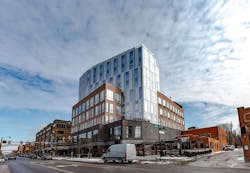800 North High Street is a highly modern building in more than one way.
It’s a fixture of Columbus, Ohio’s Short North Arts District, a neighborhood known for promoting local businesses and culture. The 10-story, 150,000-square-foot mixed-use building is home to a coworking space, two restaurants and Marriott’s new, modern hotel brand, Moxy. It also utilizes 215 tons of variable refrigerant flow (VRF) equipment, a heating and cooling technology that’s still relatively young in the U.S., though it’s gaining ground.
VRF technology is highly energy-efficient and makes it easy to provide different temperatures to different spaces, making it ideal for spaces like hotels where each guest may want a different temperature in their room. Here’s what you need to know about VRF when it comes to hotel applications.
[Related: The Emergence of VRF as a Viable HVAC Option]
What is VRF Technology?
Think of VRF as a refrigerant management system. Instead of large air ducts, VRF relies on thin pipes that move refrigerant from space to space. The system can heat, cool, or both heat and cool different spaces to meet different needs in each area.
“It’s similar to a heat pump system that one may be familiar with at home, but there are multiple zones on [a commercial] system,” explained Tom Varga, senior manager of business development for Mitsubishi Electric Trane HVAC U.S., which provided the VRF equipment for 800 North. “One of the benefits is that you can provide simultaneous heating and cooling on the same system, which is different from a heat pump.”
Hotels and VRF
Hotels are a natural fit for VRF. The technology can easily deliver different temperatures to each guest room and can also ramp down for nights with lower occupancy.
“One of the key things is that instead of costly starting and stopping a compressor like a conventional system, VRF has an inverter-driven compressor that modulates the energy usage of the system,” Varga said. “Instead of it being totally off or 100% fully on, it may modulate depending on the load. For example, if you’re only 50% occupied tonight, you can deliver with 50% of the energy. The system can keep up with varying demands… providing a simple way to control the hotel’s daily operational costs.”
Specifying VRF starts with determining whether the system needs to provide only heating or cooling or whether it needs to provide these functions simultaneously, Varga said. In a hotel, there may be nights where some guests want to cool their rooms while others want more heat, especially in spring or fall where nighttime temperatures are less predictable.
You’ll also need to determine your typical load so you know how much heating or cooling each space will need. Choose an engineer who’s well-versed in VRF so you don’t end up with a system that’s too large.
Finally, make sure your on-site staff is comfortable doing the occasional maintenance that’s required, including cleaning outdoor unit coils and filters.
“This may be new technology to a hotelier, but you don’t have to be trained significantly on the routine maintenance,” Varga said. “The functionality that’s available within the system allows a hotelier to gain control over monthly utility expenses, which is significant. If or when it comes time to sell the property, you’ve positioned property wealth.”
About the Author
Janelle Penny
Editor-in-Chief at BUILDINGS
Janelle Penny has been with BUILDINGS since 2010. She is a two-time FOLIO: Eddie award winner who aims to deliver practical, actionable content for building owners and facilities professionals.


